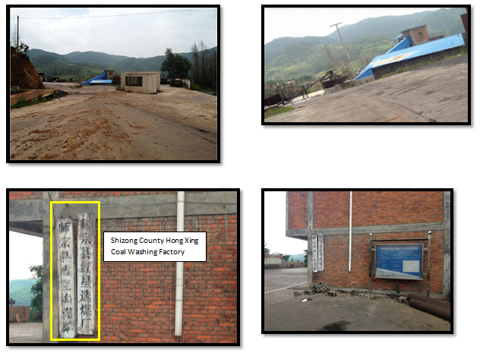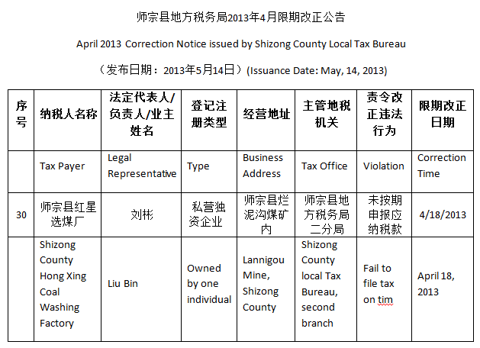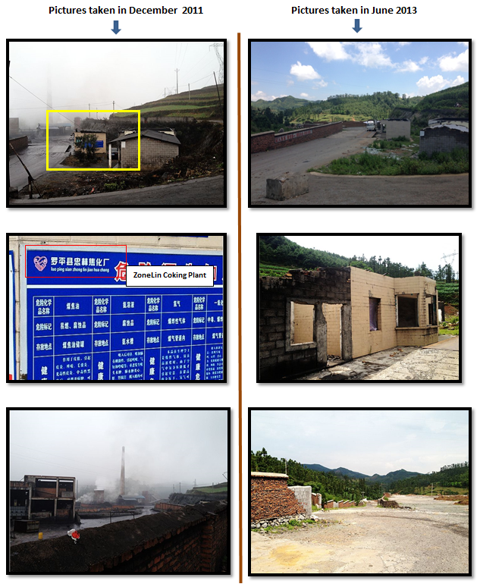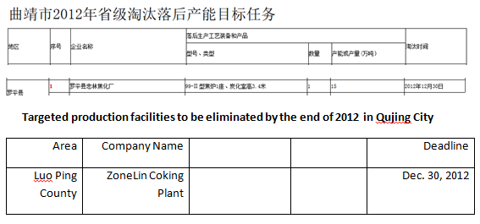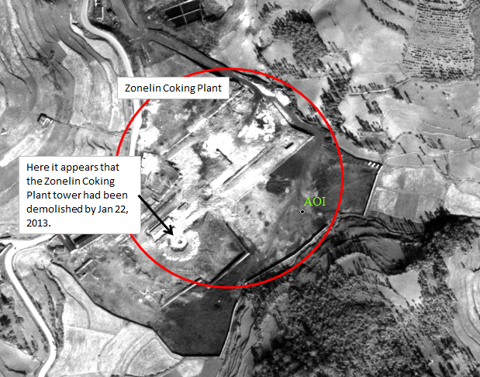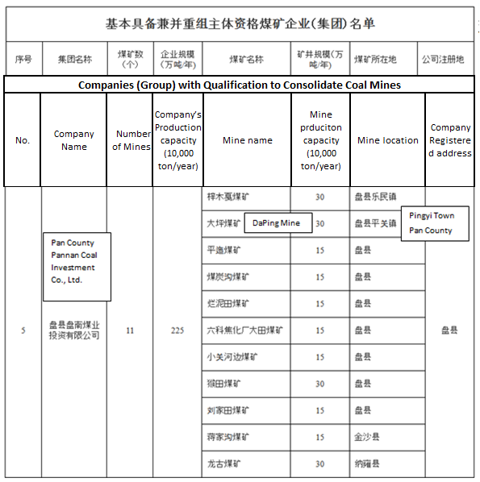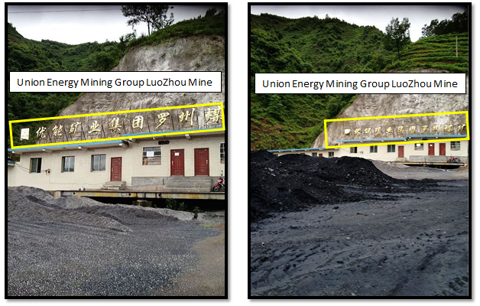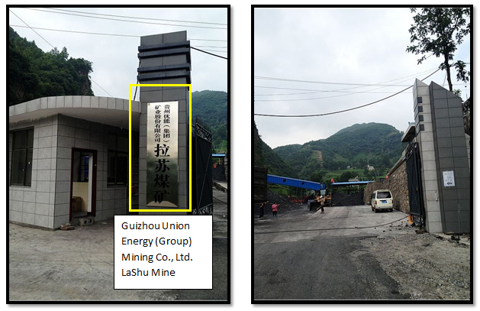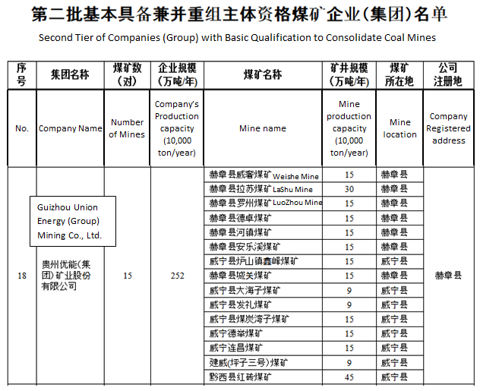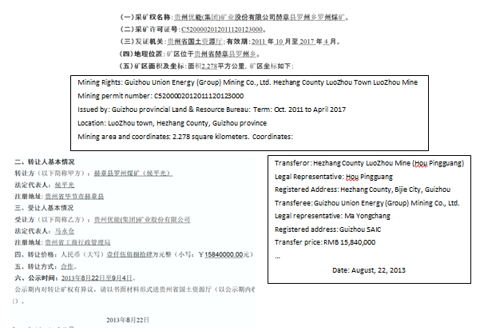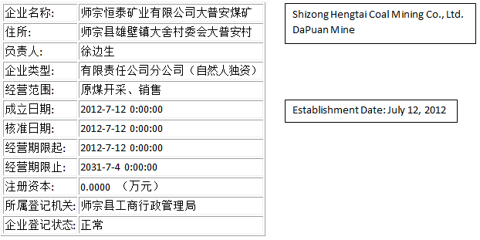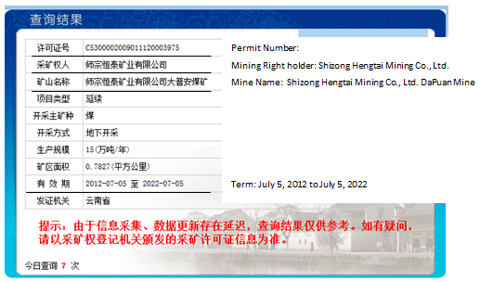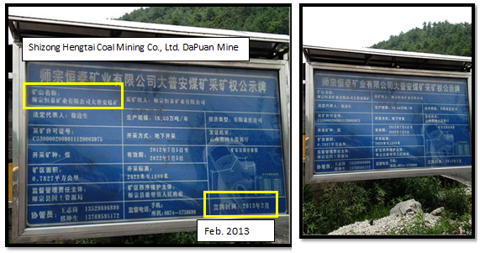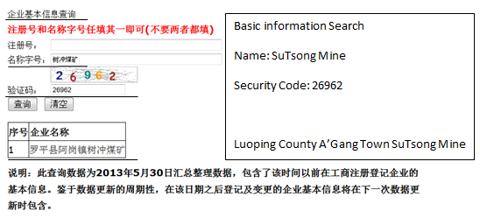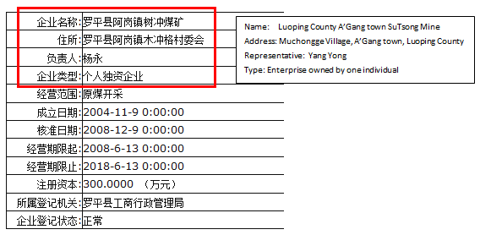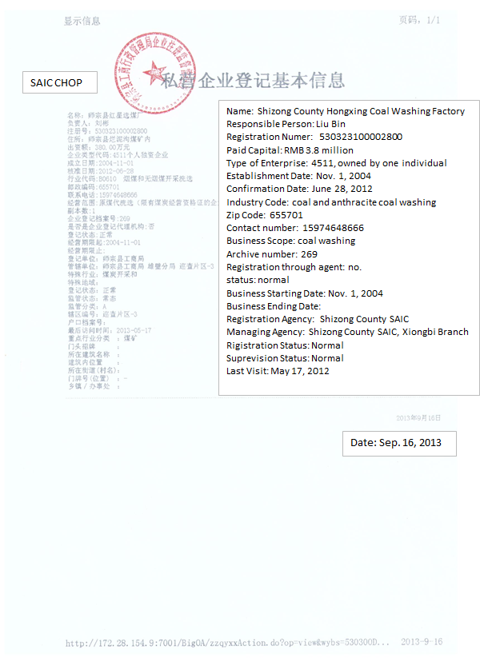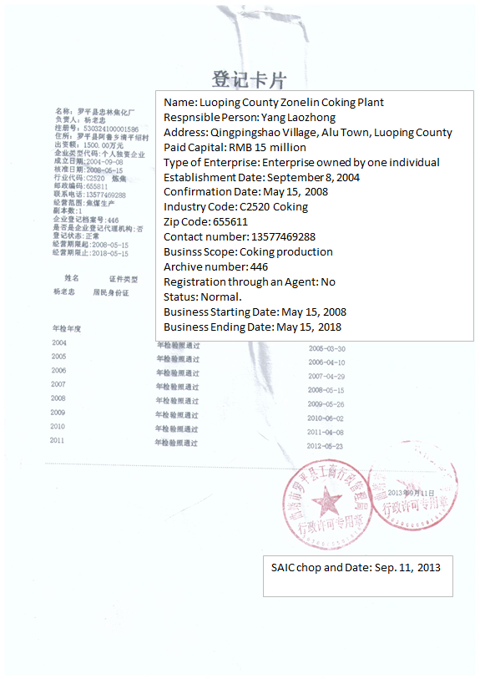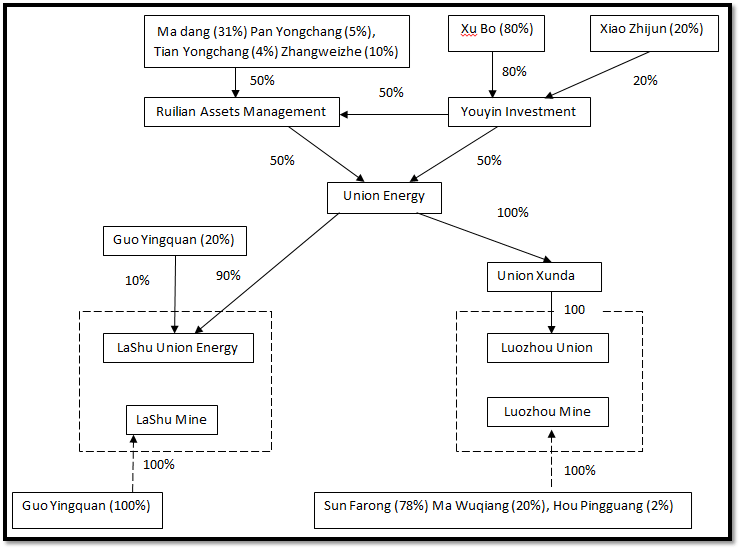Since March 2010 GeoInvesting has exposed some of the most notorious U.S. Listed Chinese company (ChinaHybrid) frauds, including six that resulted in de-listings from major exchanges. Our most recent comprehensive exposé, Longwei Petroleum – “The Most Brazen China-Based U.S. Listed RTO Fraud to Date”, published on January 3, 2013 resulted in an immediate trading halt and eventual delisting of Longwei (LPIH.OB). The stock was trading at around $2.20 at the time of our report and now trades for just pennies.
We rank LLEN as bad as or worse than LPIH based on our findings. We are assembling all of our evidence (including all of our videos/audio evidence and transcripts) to present to NASDAQ and SEC.
Background
On August 2, 2011 Glaucus Research issued a report regarding LLEN’s ownership of the DaPuAn mine, SuTsong mine, Hong Xing coal washing facility and others.
On January 13, 2012 we first informed investors that LLEN did not own the Ping Yi mine, which LLEN claimed to have owned and acquired for $4 million. We disproved LLEN’s ownership claims using SAIC filings, web postings, public articles in China, and a video interview of the legal representative of the Ping Yi mine. Instead of fully addressing our findings regarding the Ping Yi mine, on May 4, 2012, LLEN conveniently claimed it reached an “agreement” to sell the mine back to the “original owners” in exchange for future shipments of coal and future use of the mine’s coal washing facility. Hence it is clear to us that LLEN was able to report questionable revenues and earnings from the Ping Yi mine up until its ownership was effectively challenged and then conveniently disposed of the mine to avoid further debate. As our investigation will show, LLEN has now conducted a series of similar such questionable acquisitions and divestitures, inflating revenues and earnings from various questionable properties that are acquired and then somehow profitably disposed before the truth and real performance is exposed.
Summary of Findings
Revenue Misrepresentation
- LLEN’s Hong Xing Coal Washing Factory, accounting for 39% of fiscal 2013 revenues, has been shut down since 2012, according to interviews conducted in July 2013 by GeoInvesting investigators with the only remaining staff on site as well as local residents.
- Hong Xing did not file or pay any taxes to the Shizong County Local Tax Bureau since June 2012, and paid minimal taxes to the Bureau in the first half of 2012, according to our research.
- On July 31, 2013, the LLEN management team falsely claimed in its fiscal 2013 earnings conference call “…we’ve been trending up modestly on the coal washing side.” However, twenty days later, on August 19, 2013, LLEN announced in a press release: “L&L to Dispose Hong Xing Washing Facility.” GeoInvesting believes that LLEN’s abrupt decision to dispose of its purportedly profitable and growing coal washing operation was triggered by LLEN’s discovery of our ongoing investigation.
- Similar to Hong Xing, LLEN’s purportedly revenue producing ZoneLin Coking Plant was shuttered and demolished a few months prior to LLEN’s claimed $12.4M sale/exchange of ZoneLin Coking Plant to Union Energy, according to interviews with local residents, workers, and a government official. (see below)
- The government mandated decision to shut down the ZoneLin Coking Plant was first issued on June 6, 2012. On September 10, 2012 the demolition was scheduled.Acquisition/Ownership Misrepresentation
- LLEN does not own the Hong Xing Coal Washing Factory according to officially chopped (sealed) SAIC records.
- Officially chopped SAIC filings show that neither Union Energy nor LLEN own the DaPing mine and ZoneLin Coking Plant.The demolition of the ZoneLin Coking Plant prior to its alleged swap to Union Energy casts doubt on LLEN’s acquisition of the LuoZhou and LaShu mines. LLEN claims that it acquired the LuoZhou and LaShu mines from Union Energy through a November 19, 2012 “asset swap” transaction, whereby LLEN exchanged its 98% interest in the ZoneLin Coking Plant and its 60% interest in the DaPing mine for Union Energy’s 95% interests in the LuoZhou and LaShu mines. We find it highly implausible that Union Energy would want to acquire the ZoneLin Coking Plant, valued by LLEN at $12.4 million, when the ZoneLin Coking Plant was in the process of being torn down.
- The Chinese government assigned the right to consolidate the DaPing mine to another company (not Union Energy). According to local residents, Union Energy never acquired LLEN’s 60% interest in the DaPing mine.In addition to the above findings, we have referenced multiple pieces of evidence that have led us to conclude that the asset swap deal never occurred and that LLEN did not acquire, nor does it today own the LuoZhou and LaShu mines. Our evidence includes:
- Current SAIC filings show that Union Energy owns the LuoZhou and LaShu mines. These SAIC filings have the official chop (seal) of the Guizhou SAIC.
- Interviews of Union Energy management who all repeatedly assert that, while they are familiar with LLEN, Union Energy, not LLEN, is the owner of the LuoZhou and LaShu mines. Interviews with multiple LuoZhou and LaShu mine employees further confirm Union Energy’s ownership and complete control over the day to day operations and coal sales.
- Articles in local PRC newspapers and official government websites clearly show that Union Energy, not LLEN, acquired and owns the LaShu and LuoZhou mines.
- Signage apparently recently erected at both mines bears Union Energy’s name, not LLEN’s.
- Union Energy’s participation in the Guizhou provincial mine consolidation process is ongoing and well documented. Union Energy was assigned to acquire the LuoZhou and LaShu mines in March 2013 and just finalized the acquisition of mining rights for both mines in August 2013.
- The nominee who claimed to hold LLEN’s equity ownership in the DaPuAn mine and SuTsong mine is an individual who appears not to exist.
- LLEN made a misrepresentative statement regarding the legal status of the DaPuAn mine and SuTsong mine.
Our findings greatly help explain LLEN’s complete lack of free cash flow and inability to service its accounts payable resulting in a $4,983,075 highly dilutive debt for equity exchange arrangement after creditors sued LLEN in the Superior Court of the State of California for the County of Los Angeles Central District. Most importantly, $800,000 of the dilutive issuance resulted from the exchange of obligations owed to Dickson Lee, LLEN’s chairman. Effectively, Dickson Lee indirectly sued his own company and disclosed this fact only after reaching the settlement that occurred on August 14, 2013 and was buried in the proxy statement issued on August 16, 2013.
Like we did with LPIH, GeoInvesting is turning over all of its evidence to NASDAQ and the SEC.
1. LLEN’s Hong Xing Coal Washing Factory, accounting for 39% of fiscal 2013 revenues, has been shut down since 2012, according to interviews conducted in July 2013 by GeoInvesting investigators with the only remaining staff on site as well as local residents.
In its fiscal 2013 10-K, LLEN states as follows:
“We own two washing facilities with an aggregate annual coal-washing capacity of approximately 480,000 tons. The facility at Hong Xing washes coal mainly for third parties (i.e., non-affiliates to the Company.) The facility at the DaPuAn Coal mine only washes coal from the DaPuAn mine….
In April 2012, we sold our interest in Ping Yi mine and coal washing plant back to the original owners. DaPuAn only washes coal from its own mine. We have considered this as part of the total service provided within DaPuAn before the coal was sold to customer. Therefore, there was no washing for DaPuAn reported separately.”
From LLEN’s fiscal 2013 10-K/A:
“Since DaPuAn only washes its own coal from its own mine, we only listed the raw coal under the Mining Segment. We have considered this is part of the total service provided within DaPuAn before the coal was sold to customer. There was no washing reported separately.”
Therefore, LLEN’s coal washing revenues should only come from its Hong Xing coal washing facility, which mainly washes coal from third parties.
GeoInvesting investigators visited the Hong Xing facility on June 30, 2013 and July 18, 2013. We spoke to locals and a caretaker of the idled Hong Xing facility, who clearly and repeatedly stated that:
- Hong Xing has been shut down for more than one year since 2012.
- They had never heard of LLEN
We also took several pictures of idled Hong Xing Coal Washing facility:
2. Hong Xing did not file or pay any tax to the Shizong County Local Tax Bureau since June 2012, and paid minimal taxes to the Bureau in the first half of 2012, according to our research.
Since Hong Xing was shut down in 2012, it did not file or pay its taxes with the local tax bureau. The Shizong County Local Tax Bureau issued a tax filing correction warning to a group of companies, including Hong Xing, as follows:
Source: Shizong County Local Tax Bureau (excel file)
We also sent our representative to visit the Shizong County Local Tax Bureau, Second Branch. The local tax bureau confirmed that the Hong Xing Coal Washing Factory paid less than RMB 30,000 to the Shizong County Local Tax Bureau from Jan 2012 to June 2012. After June 2012, Hong Xing did not pay any tax and/or file any tax documents.
For the financial year ended April 30, 2013, LLEN reported $77.6 million in revenue and $8.2 million in net income from its coal-washing segment. It is impossible that Hong Xing only paid RMB 30,000 in taxes (around $4,900) from January to June 2012 and paid no tax after June 2012 if it actually generated anywhere near $8.2 million of net income. Furthermore, even if Hong Xing was at one time a revenue producing operation, the meager tax of RMB 30,000 paid from January to June 2012 implies a tiny operation nowhere close to $8.2 million in annualized net income. We believe the tax information further confirms our interviews of locals and the caretaker of the Hong Xing Coal Washing Factory who claimed it was shut down since 2012.
3. On July 31, 2013, the LLEN management team falsely claimed in its fiscal 2013 earnings conference call “…we’ve been trending up modestly on the coal washing side.” However, twenty days later, on August 19, 2013, LLEN announced in a press release: “L&L to Dispose Hong Xing Washing Facility.”
In the press release, LLEN stated:
“The Hong Xing Washing facility is L&L’s smaller coal washing plant located in Shezone (sic) County, Yunnan Province (“Hong Xing”). Over the past few months L&L management decided to wind down operations due to increased needs to capital expenditures. Management has decided Hong Xing will not be accretive to L&L in the long run and has stopped Hong Xing’s washing operations. Hong Xing facility is to be sold or disposed to an interested buyer as soon as possible.”
In the 10-Q dated on September 10, 2013, LLEN made statements regarding its coal washing business:
“Coal washing revenue decreased by 26% to $13.2 million during the three months ended July 31, 2013 compared with $17.8 million during the same period last year. Decrease in coal washing revenue mainly due to the idling pending on management evaluation. ”
GeoInvesting believes that LLEN’s abrupt decision to dispose of its purportedly profitable and growing coal washing operation was triggered by LLEN’s discovery of our ongoing investigation.
4. Similar to Hong Xing, LLEN’s purportedly revenue producing ZoneLin Coking Plant was shuttered and demolished a few months prior to LLEN’s purported $12.4M sale/exchange of ZoneLin Coking Plant to Union Energy, according to interviews of local residents, workers, and government officials.
LLEN made the following claim in its March 31, 2013 10-Q:
“On November 18, 2012, the Company decided to purchase two coal mines, which are LuoZhou and LaShu mines by making a swap of the 60% equity interest in DaPing mine and 98% equity interest in ZoneLin Coking Plant. The fair value of the 100% equity interest in ZoneLin is reasonably stated by the amount of RMB 77,786,000 (approximately $ 12.4 million, including $2.7 million on assets write-up per fair value measurement).”
However, based on government documents and our on-the-ground due diligence, the ZoneLin Coking Plant was already scheduled to be shut down several months before the November 19, 2012 asset swap. We find it highly implausible that Union Energy would want to acquire ZoneLin for the amount of RMB 77.8 million, or $12.4 million, when it was widely disclosed that the ZoneLin Coking Plant production line was in the process of being torn down.
The following timeline diagram outlines the ZoneLin Coking Plant developments from 2011 to the beginning of 2013:
We first visited the ZoneLin Coking Plant in December of 2011. At that time, we took some pictures of the apparently operating facility. We did not visit the ZoneLin Coking Plant again until June of 2013. By that time, the ZoneLin Coking Plant had long since been torn down. The following pictures of the ZoneLin Coking Plant in 2011 and 2013 document our findings:
In July of 2013, we spoke with local villagers who live and work around the ZoneLin Coking Plant. All of the people we spoke with confirmed that the ZoneLin Coking Plant had in fact been shut down for roughly 8-10 months prior to our visit (around August/ September/October 2012).
Furthermore, these villagers confirmed that the ZoneLin Coking Plant was owned and operated by Yang Laozhong. No one had ever heard of LLEN.
We also talked to a local governmental official regarding the ZoneLin Coking Plant. The government official also confirmed that ZoneLin Coking Plant was shut down and demolished around September and/or October 2012.
5. The government mandated decision to shut down the ZoneLin Coking Plant was first issued on June 6, 2012. On September 10, 2012 the demolition was scheduled.
On September 10, 2012, the Luoping County Information Technology Office submitted an application regarding eliminating the ZoneLin Coking Plant, as well as another company’s outdated production facility. In this application, the Luoping County Information Technology Office states the following:
Source: Yunnan Provincial Government Website
Translation:
“Currently, (eliminating) ZoneLin Coking Plant has already been in substantial process. Production line is going to be demolished and can be eliminated in accordance with required timeline by superior government.”
On Jan 14, 2013, the Luoping County Government issued the following:
Source: Luoping County Government
Translation:
“Last Year…shut down ZoneLin Coking Plant 150,000 ton coking production line and tore down all equipment… “
On June 6, 2012, Qujing City Industry and Information Technology Committee issued a notice regarding the elimination of outdated production facilities in 2012.
Source: Qujing City Industry and Information Technology Committee Website
In an attempt to gain clarity into this matter, we obtained satellite images from Jan 22, 2013 covering the ZoneLin Coking Plant. From this image, we can clearly see that the tower and other facilities on the ZoneLin Coking Plant were indeed already torn down prior to this date.
6. LLEN does not own the Hong Xing Coal Washing Factory according to officially chopped (sealed) SAIC records.
We pulled Hong Xing’s officially chopped (sealed) SAIC file as shown in Exhibit A. In fact, based on the SAIC file, LLEN does not own Hong Xing. This factory is actually owned by Liu Bin, whose name is also shown in the Hong Xing tax filing.
7. Officially chopped SAIC filings show that neither Union Energy nor LLEN own the DaPing mine and ZoneLin Coking Plant.
We have attached the SAIC file of the DaPing Mine with the official SAIC official chop as Exhibit B to show that neither Union Energy nor LLEN owns the DaPing Mine. Investors should remember that Glaucus Research already issued a report challenging LLEN’s claimed ownership of DaPing Mine.
We have attached the SAIC file of the ZoneLin Coking Plant with the official SAIC chop as Exhibit C. The SAIC file clearly shows that neither Union Energy nor LLEN own the ZoneLin Coking Plant. In fact, its registered owner is Yang Laozhong, which is confirmed by our interviews of local villagers as well.
8. The Chinese government assigned the right to consolidate the DaPing mine to another company (not Union Energy). According to local residents, Union Energy never acquired LLEN’s 60% interest in the Daping mine.
Along with its alleged 98% ownership interest of the ZoneLin Coking Plant, LLEN also claimed that it transferred its 60% interest in the DaPing mine to Union Energy:
“On November 18, 2012, as part of the acquisition of LaShu and LuoZhou Mines, the Company transferred its 60% interest at DaPing as part of the payment for the new acquisition. Therefore, all the assets and liabilities had transferred to the new owner as of November 18, 2012.”
Source: LLEN Q3 2013 10Q
However, according to a government document, during the coal mine consolidation process, Pan County Pannan Coal Investment Co., Ltd., instead of Union Energy, is assigned to consolidate the DaPing mine.
Relevant governmental approval documentation:
Source: Guizhou Energy Network
Our investigator visited the DaPing mine and talked to several local residents at DaPing mine. These individuals clearly stated that the DaPing mine was not transferred to Union Energy – and that they had never heard of a company called LLEN. (We will be providing all of these videos and transcripts to NASDAQ and SEC)
We took a close look at the DaPing mine acquisition documents filed by LLEN. The Equity Transfer Agreement clearly states:
“…
- The Target Company and Party B agree to transfer the business entity from a private proprietor ownership to a corporation; DaPing Coal Mine of Ping Guan Town, Pan County of Guizhou Province (“DaPing Co., Ltd”). Hobin is the 100% equity owner of Party B.
- Party B and Target Company will ensure Party A owns 60% (majority) equity of DaPing Co., Ltd., so that Party A will be the majority equity owner of the mine
…”
Furthermore, in its January 31, 2013 10-Q LLEN claimed that:
“On March 15, 2011, the Company entered into an Acquisition Agreement to acquired 60% equity of the DaPing Coal Mine (“DaPing”), with an effective date of March 15, 2011, for a purchase price of 112,080,000 RMB (equivalent to approximately US$17,064,815). The Company had effective control of DaPing since right after the signing of the Acquisition Agreement on March 15, 2011.”
However, we cannot find any evidence that DaPing Co., Ltd. was established after the claimed Acquisition Agreement. This leads us to conclude that it was impossible for LLEN to have received 60% equity of the non-established DaPing Co., Ltd.
9. Current SAIC filings show that Union Energy owns the LuoZhou and LaShu mines. These SAIC filings have the official chop (seal) of the Guizhou SAIC.
We obtained SAIC files of Union Energy, LuoZhou mine, LaShu mine and their related companies. Please see Exhibit D where we have created a detailed corporate chart that highlights Union Energy’s ownership of the LuoZhou and LaShu ines.
10. Interviews of Union Energy management who all repeatedly assert that, while they are familiar with LLEN, Union Energy is the owner of the LuoZhou and LaShu mines. Interviews with multiple LuoZhou and LaShu mines employees further confirm Union Energy’s ownership and complete control over the day to day operations and coal sales.
- Local workers from both the LuoZhou and LaShu mines had never heard of LLEN, and they claimed that Union Energy owns both of these mines.
- Union Energy is responsible for the day-to-day mining and coal sales.
- We spoke with Union Energy managers who insisted that Union Energy, not LLEN, is the owner of the LuoZhou mine and LaShu mine and denied LLEN’s claimed ownership of these two mines.
(We will be providing all of these videos and transcripts to NASDAQ and SEC.)
Compare our interview findings to the following transcript from the Q&A portion of LLEN’s fourth quarter fiscal 2013 conference call. The following referenced conversation exchange implies that Union Energy managers should be aware that LLEN owns these mines. But as we pointed out, the Union Energy managers denied LLEN owned the mines.
Clayton Fong – Vice President of U.S. Operations for LLEN
What we will typically do before an acquisition is we’ll actually assign managers to go onsite before we acquire and that’s part of our due diligence process, and quite frankly, one of the reasons we speed up the phase of the last few mines was the integration was so smooth and a lot of times the integration is sort of an advance.
(Further commentary from Mr. Fong)
Unidentified Participant
That’s fantastic. So it sounds like the local manager, they really consider themselves part of the L&L team if you will.
Yes, I think so. At the end of the day, what you got is a JV partnership with a very strong entity. I think Union Energy, my recollection off the top of my head is, I think they had eight mines. So we’re JV’ing on three of them. So I think it’s really very co-branded for lack of a better word. There’s still LaShu and LuoZhou mines, but I think the folks know that it’s a very strong, they know that it’s a very strong partnership.
11. Articles in local PRC newspapers and official government websites clearly show that Union Energy, not LLEN, acquired and owns the LaShu and LuoZhou mines.
These recent articles discuss matters such as safety measures at the mines Union Energy owns (including LuoZhou and LaShu), Union Energy’s acquisitions of the LuoZhou and LaShu mines, and even cover Union Energy’s college scholarships provided on behalf of the LaShu Mine.
March 8, 2013, Hezhang Newspaper carried the following information:
Source: Hezhang Newspaper
Translation:
“…In our county, 28 mines under different group companies to evaluate the gas prevention capacity are as follows: Guizhou Union Energy Mining Co., Ltd. (Weishe Mine, LuoZhou Mine, Dezhuo Mine, LaShu Mine, Chengguan Mine, Hezhen Mine and Anlexi Mine), pass…”
April 17, 2013, Hezhang Newspaper carried the following information:
Source: Hezhang Newspaper
Translation:
“…Guizhou Union Energy Mining Co., Ltd. fully and/or controlling acquired Weishe Mine, LaShu Mine, LuoZhou Mine, Chengguan Mine, Anlexi Mine, Hezhen Mine and Dezhuo Mine….”
June 14, 2013, Hezhang Newspaper carries the following information:
Source: Hezhang Newspaper
Translation:
…Guizhou Union Energy Mining Co., Ltd. fully and/or controlling acquired Weishe Mine, LaShu Mine, LuoZhou Mine, Chengguan Mine, Anlexi Mine, Hezhen Mine and Dezhuo Mine….
Sep. 5, 2013, Hezhang Newspaper carries the following information:
Source: Hezhang Newspaper
Translation:
“…five students of Minxiang village are admitted to different colleges. LaShu Mine of Guizhou Union Energy Group, which is located in Minxiang village, provided scholarships to these five students…”
12. Signage apparently recently erected at both mines bears Union Energy’s name, not LLEN’s.
On LLEN’s website, LLEN conveniently does not show its sign at the LuoZhou or LaShu mines, only showing two pictures – one of each mine. While we agree that these two pictures seem to be real pictures of the mines they are certainly no indication of LLEN’s ownership of the mines. Pictures we took in June and July of this year clearly show that Union Energy still owns and operates the mines.
Pictures of LuoZhou Mine
Pictures of LaShu Mine:
13. Union Energy’s participation in the Guizhou provincial mine consolidation process is ongoing and well documented. Union Energy was assigned to acquire the LuoZhou and LaShu mines in March 2013 and just finalized the acquisition of mining rights for both mines in August 2013.
On March 27, 2013, the Guizhou provincial Coal Mine Consolidation Office issued a list of companies that are basically qualified to consolidate coal mines in Guizhou province. In this list, Union Energy is assigned to consolidate 15 different coalmines, including LuoZhou, LaShu, and even the Weishe mine as well. The information and the following snapshot can currently be viewed directly from a government website.
Source: Guizhou Energy Network
Following this approval in March 2013, Union Energy consolidated the LuoZhou mine and the LaShu mine. Accordingly, the Guizhou provincial Land & Resource Bureau announced the LuoZhou mine’s mining rights transfer to Union Energy on August 22, 2013, and the LaShu mine’s mining rights transfer to Union Energy on August 28, 2013.
Source: Department of Land & Resource of Guizhou Province
Source: Department of Land & Resource of Guizhou Province
If in fact Union Energy did transfer 95% ownership stakes in the LuoZhou mine and the LaShu mine to LLEN on Nov. 19, 2012 (which we do not believe to be true), it would consequently be impossible that Union Energy acquired the mining rights of the LuoZhou mine and LaShu mine again in August 2013.
14. The nominee who claimed to hold LLEN’s equity ownership in the DaPuAn mine and SuTsong mine is an individual who appears not to exist.
LLEN made the following disclosure in its 2013 10-K:
“We own our equity ownership interest in the DaPuAn and SuTsong Mines through a nominee who is a Chinese citizen that holds our equity ownership in trust for our benefit under an agency agreement executed in April 2008, and we refer to the operations as “L & L Coal Partners”
In the Acquisition/Joint Venture Agreements and the Agent Agreement, Han Jun is the claimed agent for LLEN to execute multiple agreements.
Agreement (provided by LLEN) with LLEN and claimed Agent
“Principal: L&L International Holdings Inc. Agent: Jun Han (ID of Chinese citizen: 530103195910180614)”
Source: Exhibit 10.19 Agency Agreement of January 6, 2013 LLEN S-1
Agreement (provided by LLEN) with SuTsong Coal Mine and claimed Agent
“Party A: HAN, Jun
Address:
ID No: 530103195910180614Party B: YANG, Yong
Address:
ID No: 530323198811150952Party C: Luoping County A’ang Town SuTsong Coal Mine
Address: A’ang Town, Luoping County, Yunnan Province, China
Person in Charge: YANG, Xiaoshu”
Source: Exhibit 10.23 of January 6, 2013 LLEN S-1
Without exception, every Chinese citizen carries an 18 digit ID number that is recorded in a National Citizen Identity Information Center government database, (NCIIC). First we looked up the ID number of the owner of the SuTsong Coal Mine, YANG, Yong. With one click of a mouse we confirmed the existence of his ID number. However, the ID number of HAN Jun appears not to exist at all. Investors can search for themselves any valid ID number in the Chinese National Citizen ID Inquiry Service Center.
When we input Jun Han’s alleged ID number into the search bar, it shows that Jun Han’s ID number does not exist. The search result is as follows:
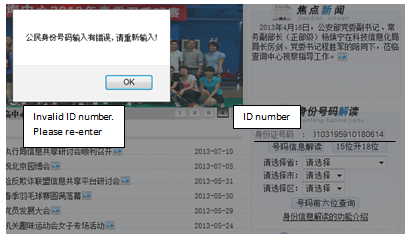
Source: Chinese National Citizen ID Inquiry Service Center
According to our research we can say that no such person named HAN Jun carries the ID number “530103195910180612” in China.
Now, we did find a valid ID number, “530103195910180612,” which ends with “2”, rather than the “4” ending Jun Han’s ID number, “530103195910180614”. The name of the valid ID number “530103195910180612” is not HAN Jun, but Chu Huiping. In fact, no ID with the first 17 digits of the ID in question carries an 18th digit other than 2. The information of Chu Huiping with the ID number “530103195910180612” is as follows:
15. LLEN made a misrepresentative statement regarding ownership of the DaPuAn mine and SuTsong mine.
In its 10-Q for the period ended January 31, 2013, LLEN made the following statement regarding DaPuAn mine and SuTsong mine:
“In December 2012, China’s National Policy changed to allows sole proprietorship of mines to be changed to special limited company. The Company made these changes on March 1, 2013. The name of DaPuAn Coal Mine (“DaPuAn”) has been changed to Shizong HengTai Coal Mining Co., Ltd. DaPuAn Mine (“HengTai DaPuAn”). Similarly, SuTsong Coal Mine (“SuTsong”) has been changed to limited partnership structure. Under the agreements, the Company still has 80% of the equity in both of HengTai DaPuAn and SuTsong. The transactions do not impact the existing ownership of both mines by the Company.”
We will show that the DaPuAn name has been effect since July 2012 and was never changed since this date and that the SuTsong Coalmine was never changed to a limited partnership as it is still an enterprise owned by one individual.
a. DaPuAn Mine has maintained its current name from July 2012, rather than March 1, 2013.
Based on the SAIC file, the Shizong Hengtai Coal Mining Co., Ltd. DaPuAn Mine was established on July 12, 2012. The SAIC information is as follows:
Source: Yunnan SAIC
One week before the establishment of the Shizong Hengtai Coal Mining Co., Ltd. DaPuAn Mine, on July 5, 2012, the mining right was already issued to Shizong Hengtai Coal Mining Co., Ltd. DaPuAn Mine. This is the relevant mining right information in the database of Ministry of Land and Resource of China:
Source: Ministry of Land and Resource of P.R China
Clearly, as of July 2012, Shizong Hengtai Coal Mining Co., Ltd. DaPuAn Mine was established and the Chinese government issued a mining rights permit to this company. Given these facts, we conclude the statement made by LLEN regarding the name change is completely inaccurate.
Our investigator also visited the DaPuAn mine and took several pictures outside of the facility.
This board carries the DaPuAn mine’s mining rights permit information. On this board, it clearly states that the name of the mine is the Shizong Hengtai Coal Mining Co., Ltd DaPuAn Mine. More importantly, the date on this board was February 2013. This means that as of February 2013, DaPuAn Mine had already changed its name to the Shizong Hengtai Coal Mine Co., Ltd DaPuAn Mine. This contradicts the statement that “the Company made these changes on March 1, 2013.”
b. Government documents indicate that the SuTsong mine did not change to a limited partnership as claimed by LLEN.
The Yunan provincial SAIC database can be searched online. A keyword search of SuTsong Mine brings up Luoping County A’Gang Town SuTsong Mine. The search clearly states that all of the data is from May 30, 2013.
Next, we followed a link, “SuTsong Mine”, to obtain the additional information:
Source: Yunnan SAIC
These documents indicate that the SuTsong mine is still an enterprise owned by one individual, Yang Yong, rather than a limited partnership as claimed by LLEN.
End of Report.
EXHIBIT A
EXHIBIT B
EXHIBIT C
EXHIBIT D
Disclosure: I am short LLEN. I wrote this article myself, and it expresses my own opinions. I am not receiving compensation for it. I have no business relationship with any company whose stock is mentioned in this article.
